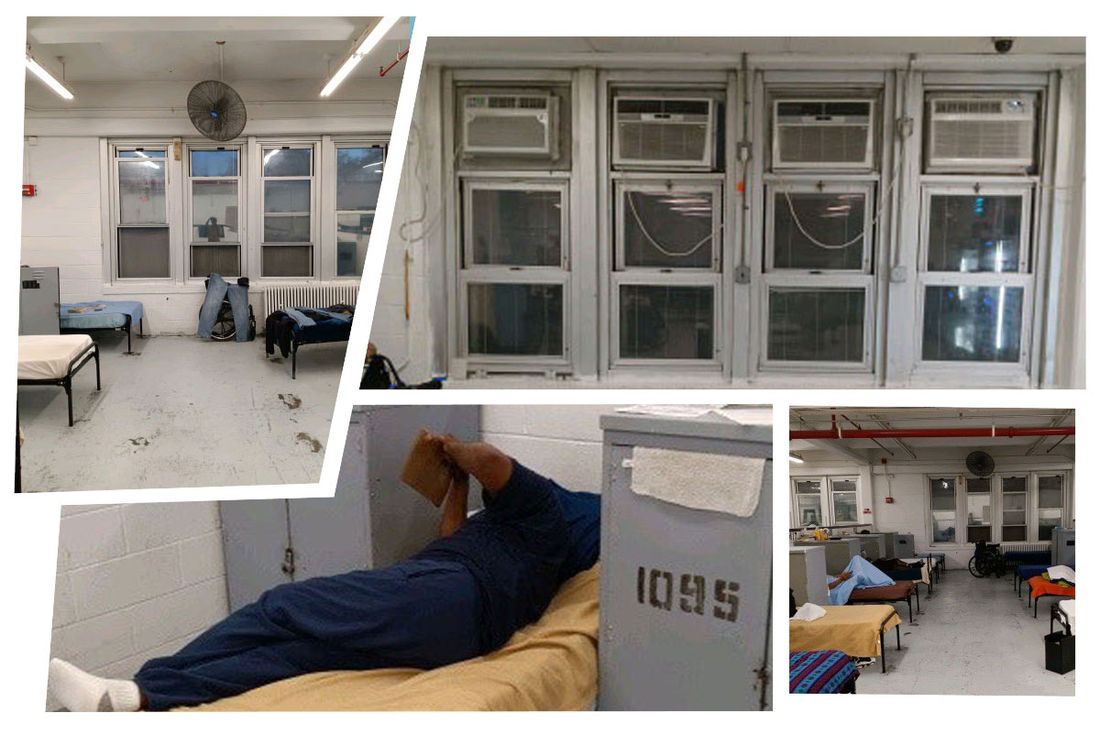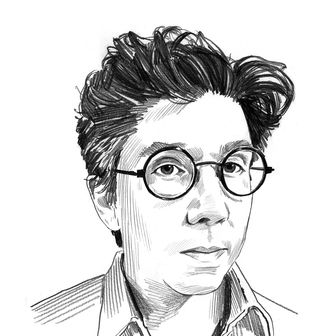
When the M35 pulled up to its stop at 125th Street and Lexington Avenue last Thursday, Mike Colón was among the crowd of 30 or so people who got on the already crowded bus going out to Wards Island. It was 9:25 p.m., and the only other free route to the island was a walk over the Robert F. Kennedy Bridge, but that would take awhile, and he — like most everyone else there — needed to get home before curfew at the top of the hour. Colón, 33, has lived since 2018 at the HELP USA Meyer Mental Health Shelter, a facility run by Maria Cuomo Cole, the soon-to-be-former-governor’s sister, mainly for people who require psychiatric assistance. It’s just across a salt marsh from a soccer field named for Wall Street investor Carl Icahn, the world’s 124th wealthiest person.
“It’s the most depressing place you could ever be,” Colón said.
The bus ride took a little over ten minutes. Maybe half the riders wore masks. Colón, who was coming back from work, is required as a condition of his parole to stay at the shelter. One of his concerns, he said, is the lack of ventilation there. When the COVID-19 pandemic first started, the virus tore through HELP Meyer, killing a handful of residents and sickening many more. (Ed. note, August 19: After publication of this story, HELP Meyer’s representatives disputed that people had died there.) “It was bad,” he said. “There was no ventilation. Coronavirus was happening. It was spreading fast,” Colón said.
“Multiple people died! Mad people died,” said Danul Williams, a friend of Colón’s who was sitting nearby. Williams lives in Clarke Thomas, one of the three other shelters on Wards Island run by HELP USA where, he said, the living situation is similar. “No ventilation — none of that shit. All they did was, they might have moved a bed.”
Colón isn’t vaccinated — “too new,” he said of the vaccine — but wears a surgical mask that slides down his nose as he talks. Inside the Meyer Shelter’s sleeping areas, some of the windows are sealed shut.* It can get sweltering there during the summer. Sixty or so people have beds spaced a few feet apart. “There’s no ventilation going on,” he said. “It’s horrible.”
New York City is in the midst of moving about 8,000 homeless residents from hotels, where they were temporarily housed to slow the spread of the virus, back to the group shelter system. While the move has been slowed by the courts, interviews with residents, lawyers, health specialists, and activists — as well as video and photos that I saw — show that the facilities the city judged so inadequate during the early days of the pandemic have seen few, if any, upgrades since. What paved the way for the sudden move back was a recent decision by the Cuomo administration to loosen ventilation requirements on sites where air flow is apparently minimal.
The homeless population is among the least-vaccinated in the city. It’s unclear how many people in the system have got the shot, but DHS has vaccinated about 20 percent of clients as of July, and more could have received shots outside the shelters. Experts say the rush to move them back to shelters, combined with the lack of air-quality upgrades, is likely to sicken and kill people. “This is a slow-moving train wreck,” said Joshua Goldfein, an attorney for the Legal Aid Society’s Homeless Rights Project. “It’s just reckless on public-health grounds, if nothing else, to send people to sites where there are likely to be superspreader events that will radiate out to the community.”
The shelter situation in New York has been one of the most fraught, upsetting fault lines of class, race, and inequality that have been laid bare during the pandemic. The city partnered with more than 60 hotels last April in a temporary program to move homeless residents out of large, shared spaces and into their own rooms. But residents of neighborhoods like the Upper West Side complained about a rise in public urination, fighting, and people sleeping on the streets in areas where public displays of homelessness had been rare.
While the hotels program was running, New York State was planning to make the shelter systems safer. In September, the state Office of Temporary and Disability Assistance issued a 13-page guidance letter saying that shelters housing 25 or more “must include air filtration and ventilation procedures in their plans that maximize the health and safety of residents, particularly those who are most vulnerable and at risk for severe illness from COVID-19.” Among the mandates were installing air filters, fixing central air systems, and even maintaining humidity between 40 and 60 percent.
“The September guidance was significant,” Jacquelyn Simone, senior policy analyst at Coalition for the Homeless, told Curbed. “We were under the impression between September and the spring, when DHS began phasing out the use of its hotels and returning people to congregate shelters, that it would be operating under the OTDA guidance.” The Coalition had learned the New York City Department of Homeless Services had submitted two ventilation plans to the state for approval, but neither was made available. (The city and state didn’t comment about the city’s proposed plans. HELP USA didn’t return voice-mails seeking comment, and a request to speak with a spokesperson was directed to a line that went unanswered.)
Everything changed this summer — except the buildings themselves. This June, a New York appeals court dismissed a lawsuit seeking to keep a group of homeless men in the Lucerne, essentially clearing the way for the end of the hotels program. Soon after, the Cuomo administration quietly issued updated ventilation guidelines. Directives that said shelters “must” include ventilation procedures were softened to say they “should.” Specifics about filtration levels and humidity were gone. In total, the new guidance weighed in at six pages, less than half the length of the rules nine months before. Last week, a judge delayed by as much as two weeks the move back to the shelters for some disabled residents.
Meanwhile, the city did little to improve the air quality in the shelters. A spreadsheet of capital improvements made by DHS during the pandemic showed one ventilation upgrade for a family shelter, where people are housed in discrete units, but did not show any such improvements to congregate shelters for single adults, Simone said. While that doesn’t rule out that a private landlord could have upgraded ventilation, the Coalition wasn’t aware of any changes like that, she added.
If there was a reason behind the looser ventilation guidance issued this September, it’s unclear what that was. “The June guidance was issued after the governor had lifted COVID-19 restrictions,” Anthony Farmer, a spokesman for OTDA, said in a statement. “The guidance had been reviewed by the state Department of Health and is consistent with CDC guidance.” (DHS didn’t respond to queries about ventilation and the state of the Wards Island shelters, apart from a standard quote expressing appreciation for “the Court’s continued careful consideration.”)
“My concern is everything we knew about HVAC systems and circulation was all in a pre-Delta world. Now, we have this new variant that we know is much more transmissible,” Dr. Kelly M. Doran, an emergency doctor at NYU Langone who focuses her research on homelessness, said. “These congregate shelters are riskier than other settings, and it’s one of the reasons why, for example, masks are still being recommended.”
New York City is now averaging about 1,600 new virus cases a day, an eight-fold increase from the low of late June, according to city data. Not only could this lead to more people dying in the shelters, but it could jump-start the spread of the virus, yet again, throughout the city. “Sometimes people think this is a closed system, like those people are just in shelters,” Dr. Doran said. “The same people in shelters are moving in and out, they’re riding public transportation, they’re going into schools, they’re going into workplaces. And then, of course, you have all the staff.”
“There have been cases, certainly in the past few weeks, where someone who has COVID was sleeping in a dorm with many other people,” Simone said. When people are exposed, DHS typically moves them to quarantine facilities, she added.
Clarke Thomas, the facility that HELP USA is running in a $45 million deal, was described by seven current and former residents as one of the worst shelters in New York City — a place where the synthetic drug known as K2 was rampant, violence was common, and the roof leaked. The residents said there are multiday stretches without hot water and there are no medical facilities on-site. Samuel Irvin, a Clarke Thomas resident since October, said on Sunday they served bread with jelly as a meal. At night, the three-story building at the end of Hell Gate Circle appears to have the windows in the sleeping areas open only a few inches.
Pictures and videos of the inside seen by Curbed paint a picture where there’s little social distancing, masking, or ventilation. In one picture taken Sunday night, a group of three men in wheelchairs on the first floor crowd around four windows, one of which is closed entirely. The men are at the far end of two rows of five beds, and two men are resting in neighboring beds a few feet apart. Another resident sent a video showing a fan near a window bay on the third floor had been removed. Pictures sent by a third showed toilets smeared with feces, which he said had been in that condition all day.
“Ventilation? What ventilation?” said Irvin, 60, a disabled Marine veteran who was moved out of a Howard Johnson’s hotel in Queens. “There’s air conditioners in the cafeteria, in the counselor’s office, and back where the kitchen is. But where we’re sleeping at, there’s nothing. We have to open up the window and turn up the fan. We’re burning up back here.”
*Ed. note, August 19: An earlier version of this sentence stated that none of these rooms were air-conditioned; HELP Meyer notes that a/c units are present, and we have removed that reference.






